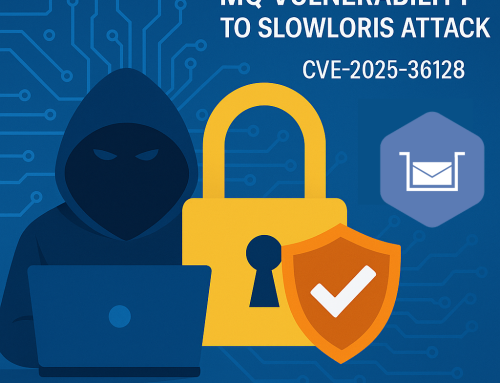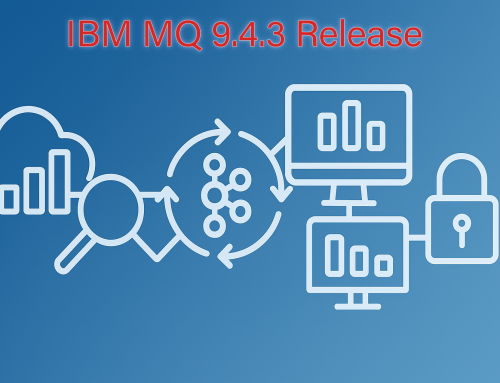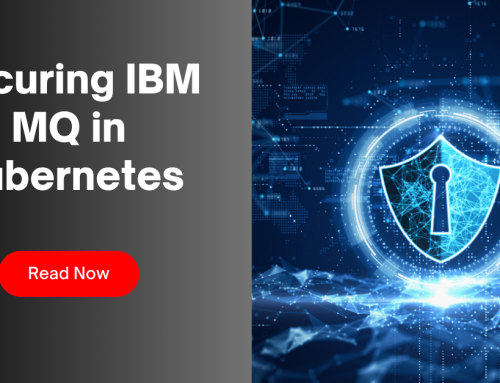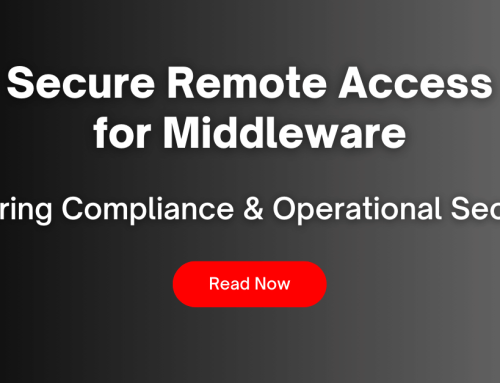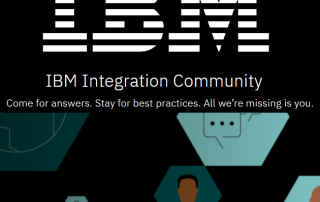- Introduction
- #1: Administrators can be more Productive by Managing More Servers, More Easily
- #2: Reducing Server Downtime Can Help Administrators Be More Productive & Cost-Efficient
- #3: Significantly Improve MTTR (Mean Time to Resolution) Has Huge Impacts On Administrators Productivity & Cost-Efficiency
- #4: ZERO Major Outages per Year has tremendous impact on an Administrators Productivity
- But How Can an Administrator be more Productive & Cost-Efficient Today?
4 Ways IT Administrators Can Be More Productive & Cost Efficient
The following 4 ways IT Administrators can be more productive and cost efficient are a helpful guideline for steps you can take today to help your organization.
Introduction
Gartner Speaks on the Cost of IT Skills
According to Gartner, skilled positions like IT Admins have endured heavier and heavier workloads over the last decade. Add to that the fact that IT budgets will see slowed growth worldwide in 2023 (Gartner, 2023), admins are under increasing pressure to do more with less.
With limited resources and shrinking budgets, IT teams need to find ways to be more productive and cost-efficient while still delivering high-quality work to their organizations. In this article, we will explore four ways that IT administrators can increase their productivity and efficiency, while also reducing costs. By following these best practices, IT administrators can help their organizations achieve greater agility, responsiveness, and competitiveness, while also maximizing the value of their IT investments.
#1: Administrators can be more Productive by Managing More Servers, More Easily
There are many solutions out there that can help you accomplish this. Using one to manage more servers while at the same time using fewer resources, you improve:
Efficiency:
Managing multiple servers can be time-consuming and tedious, especially when it comes to performing routine tasks such as updates and backups. By using an automated management solution, admins can improve efficiency and productivity, freeing up more time for mission-critical tasks.
Consistency:
When managing many servers, it’s important to maintain consistency across all of them. By using solutions that allow for easy management of multiple servers, IT admins can ensure that all servers are configured and maintained in a consistent manner, reducing the risk of errors and security vulnerabilities.
Scalability:
As an organization grows, so does its IT infrastructure. Being able to manage more servers easily will allow admins to easily their infrastructure without sacrificing manageability. We will get to this later, but an agentless solution for IT Management will tremendously help with scalability.
Cost-Effectiveness
With the ability to manage more servers, admins can reduce the need for additional staff or resources to manage their IT infrastructure. This can result in huge cost savings for the organization as highly-skilled positions like IT Admins, continue to soar. (Dice, 2022)
Security:
Effective server management is critical for ensuring the security of an organization’s data and systems. By being able to manage more servers, admins can quickly identify and address security vulnerabilities across their entire infrastructure, reducing the risk of data breaches and other security incidents.

#2: Reducing Server Downtime Can Help Administrators Be More Productive & Cost-Efficient
One of the KPIs that many IT Admins have in their SLAs is reduced server downtime. There are many reasons why this is important but here are the most essential ones.
Reduced Maintenance:
Server downtime requires immediate attention and is usually very costly for the organization. By reducing downtime through proactive maintenance and monitoring, IT admins can prevent many of these emergencies from happening in the first place, thus reducing the need for costly fixes.
Coming back to agentless solutions, you should consider an agentless solution to help you reduce server downtime and maintenance costs as an agentless solution provides a non-intrusive way to monitor and manage servers without the need for additional software or hardware agents. This allows IT admins to monitor and manage servers remotely (which is a huge bonus for everyone who enjoys working from home) without the need for additional maintenance tasks that a solution with agents requires. Therefore, you do not need to install and configure software or hardware agents on every single server, which becomes increasingly time-consuming the more servers you have, and the more your organization grows. An IT administrator can become so much more productive and cost-efficient by looking for agentless solutions.
True Real-Time Monitoring:
Real-time monitoring can help reduce server downtime by providing admins with immediate visibility into the performance of servers and their underlying infrastructure, usually with dashboards to intel data quickly. By monitoring servers in real-time, admins can quickly detect issues as they arise and take corrective action before they result in downtime.
Here is why you need a solution with TRUE real-time monitoring, and to look out for ones that only write to logs, and monitor servers based on averages from those logs.
Early Detection of Issues:
Real-time monitoring allows admins to detect issues as they arise, often before they cause significant downtime or damage. This allows them to take corrective action quickly, minimizing the impact on business operations.
Proactive Maintenance: (More Maintenance Savings!)
Real-time monitoring can also enable admins to proactively identify potential issues and address them before they become major problems that require downtime. By addressing issues proactively, IT admins can reduce the likelihood of downtime and minimize maintenance costs significantly.
Rapid Response to Issues:
Real-time monitoring can also enable admins to proactively identify potential issues and address them before they become major problems that require downtime. By addressing issues proactively, IT admins can reduce the likelihood of downtime and minimize maintenance costs significantly.
Secure Self-Service and Collaborative Issue Resolution
Secure self-service and collaboration issue resolution is an important aspect of IT support. By providing users with a secure self-service portal and collaboration tools, IT admins can improve the efficiency and responsiveness of many problems. This can help minimize the impact of issues on business operations and improve user satisfaction. This is important as a survey conducted by Forrester Research found that 72% of respondents prefer self-service support over picking up the phone or sending an email to a support team. (Leggett, 2016).
In addition, secure self-service and collaboration tools can help minimize security risks by providing a controlled and secure environment for users to access IT resources and collaborate with IT support teams. This can help prevent unauthorized access and reduce the risk of data breaches or other security incidents.
For example, say you can make rules that make it impossible for users who you have given server access, to see or do anything they are not supposed to. You can delegate routine administration tasks that would normally be a drain on your time and productivity. This would allow you to help Dev teams, Engineers, Architects, and Ops teams help themselves without any worry about maintaining compliances.
Similarly, when issues come up that require SMEs to see and understand what’s happened, you could set up automated notifications and the initiation of secure and compliant collaborative resolution. You can get input from the teams who you need input from, can give input to the teams that need it, and share information with the appropriate teams without worries. This leads to proactive management which is proven to result in fewer incidents and overall reduced downtime as we discussed earlier which helps Administrators overall become more productive.

#3: Significantly Improve MTTR (Mean Time to Resolution) Has Huge Impacts On Administrators Productivity & Cost-Efficiency
Improving Mean Time to Resolution (MTTR) can provide several benefits to IT teams and organizations. By reducing the time it takes to resolve IT issues, employees can get back to work faster, minimizing the impact of downtime and reducing the loss of productivity. The longer an IT issue remains unresolved, the more it can impact the business and potentially result in increased costs due to downtime. Improving MTTR can help minimize these costs and improve the bottom line. Additionally, by improving MTTR, IT teams can identify and address issues more quickly, allowing them to focus on other critical IT tasks and responsibilities. For organizations that are subject to compliance requirements in their SLO’s, improving MTTR can help ensure that IT issues are identified and resolved within the required timeframes.
#4: ZERO Major Outages per Year has tremendous impact on an Administrators Productivity
Zero major outages would have a tremendous positive impact on any organization. Major outages can result in significant downtime, which can lead to lost productivity, missed deadlines, and decreased customer satisfaction. By eliminating major outages, organizations can ensure that critical systems and applications are always available and reliable, reducing the risk of lost revenue and damaged reputation. Additionally, zero major outages can lead to high employee morale and job satisfaction, as employees can focus on their work without worrying about IT issues and downtime. Eliminating major outages can also help organizations meet compliance requirements and avoid potential legal or financial penalties.
But How Can an Administrator be more Productive & Cost-Efficient Today?
Finding an Easier, More Secure, And More Capable Way
Is there a solution that can accomplish all of the above? Yes! Infrared360® by Avada Software is designed to make IT administration, especially for Middleware Managers, like MQ Admins, smarter, easier, and more secure. In truth, Infrared360 allows you to do things that you simply cannot do without it (or at least not without a LOT of additional work).
Infrared360® helps you:
Manage More Servers, More Easily
Infrared360 was designed to provide MQ Admins with smarter, easier, more secure MQ management. It has a slew of features and capabilities that let you manage more with fewer resources and less time. Customers report that they are able to manage more than 4 times as many servers per Admin when using Infrared360.
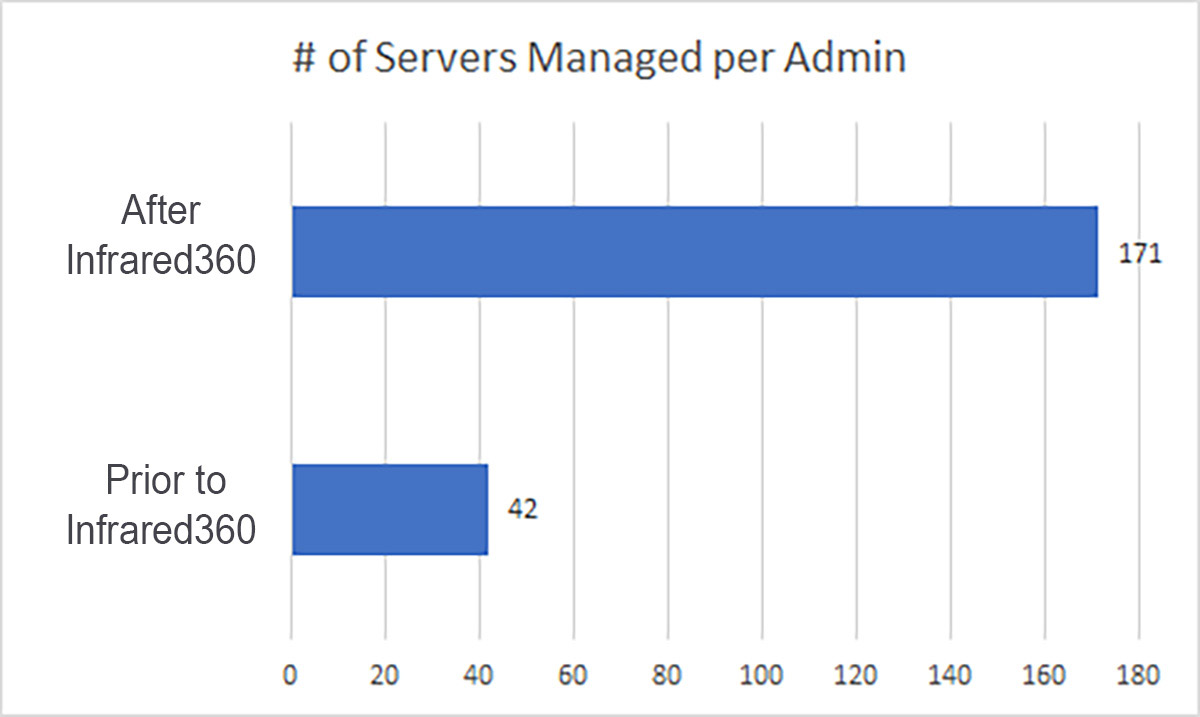
Reduce Server Downtime
Since there are no agents or scripts with Infrared360®, there is no deployment time or maintenance time. Either could mean downtime in certain instances, but these simply don’t exist with Infrared360®. Infrared360® also is built with True Real-Time Monitoring. In one instance, a user testing implementation of Infrared360, the Admin team received a notification from Infrared360 and fixed the problem before their existing monitor even registered there was an issue.
While Infrared360 writes to logs, we monitor the servers in True Real-Time™ reducing downtime and the number of incidents overall (especially since you can set automated incident resolution in cases where that’s applicable

Significantly Improve MTTR (Mean Time to Resolution)
We’ve seen customers who have gone from an average time to resolution of 120 minutes all the way down to 15 minutes. Of course, this in itself can lead to reduced downtime since you’re able to catch and resolve issues before they lead to downtime. But aside from downtime, reduced MTTR means better UX, fewer missed SLAs, improved performance, increased customer satisfaction and other business-critical metrics.
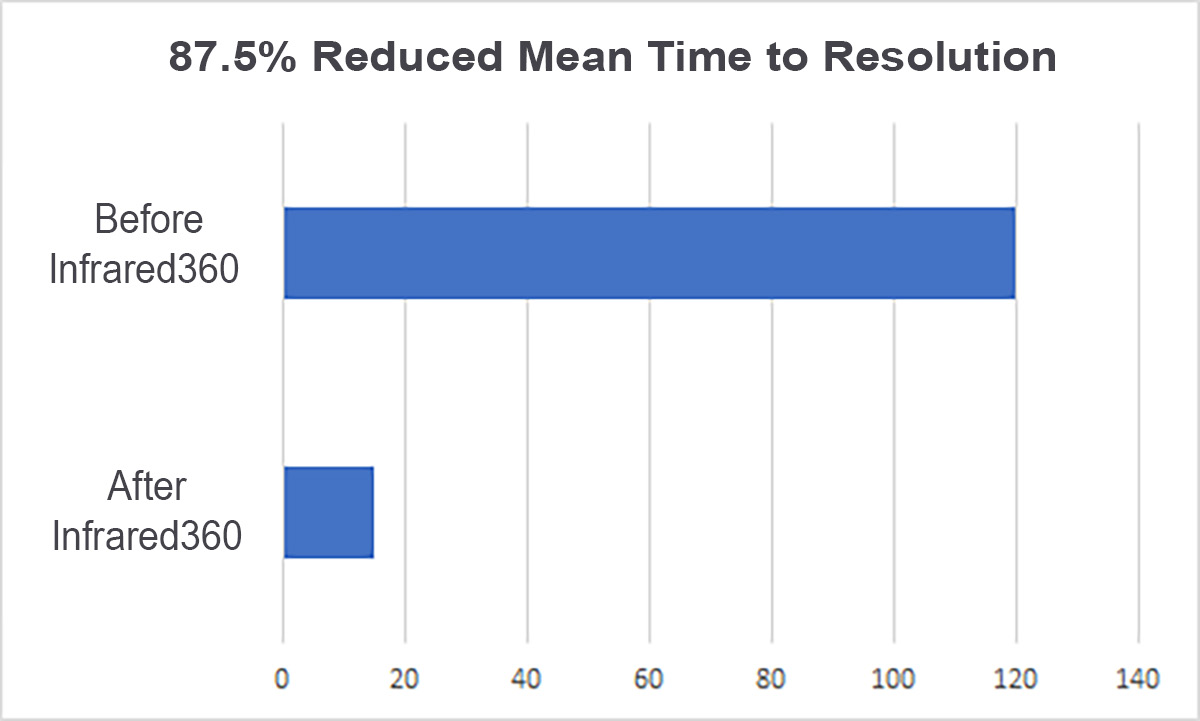
Have ZERO Major Outages per Year
This one is a byproduct of all the above. When you have reduced server downtime and reduced MTTR, you tend to have fewer major outages. And Infrared360 is outstanding in this regard. We’ve seen customers go from an average of 13 major outages a year, down to zero after implementing and training on Infrared360. You may not see 15 major outages a year, but how much is it worth to your organization to stop just one?
Here are examples of things that all help with the above:
- Create 100 messages at once with the click of a button
- Bookmark a search of objects (queues/channels/etc) save that bookmark as a Favorite for reuse by any user.
- Alter object attributes across 100s of queues without scripting or accessing each object in each Queue Manager
- Send synthetic transactions to any type or number of queues, at any interval, for any duration
- Automate actions based on alert notifications (this is native in Infrared360, so you don’t need scripts that you have to deploy, maintain, and hope don’t become legacy problems).
- Automate time-consuming tasks like resequencing and restarting Channels
- Automate retrying of messages from the Dead Letter Queue
- Full or partial backups of Queue Managers & definitions, and a whole plethora of other things
- There are a LOT more. We can show you them on a live environment. Take a few minutes for you and your team to see them firsthand.

You’ve learned some ways how IT Administrators Can Be More Productive & Cost Efficient:
Let’s get more Specific!
Let’s get more Specific!
We’ve shown you some key ways that Infrared360® can help make your IT teams and Administrators using middleware more productive and save your organization money. But these are just general terms. Let’s have a brief conversation about how your IT is managed your organization and we can get very specific about how Infrared360® will help you. We’ll even show you on a live environment. Let’s have a brief chat.
See what other Admins have said how Infrared360 has helped their organization.
As an MQ administrator, I estimate that IR360 provides an order of magnitude reduction in the time normally required to perform MQ administration tasks using competing products. I’ve used many monitoring/administration tools, and IR360 shines in comparison
IBM MQ Administrator, Banking: 1B – 3B USD
References
Dice. (2022). Tech Salary Trends. Retrieved from Dice.com: https://www.dice.com/technologists/ebooks/tech-salary-report/salary-trends.html
Gartner. (2023, January 18). Gartner Forecasts Worldwide IT Spending to Grow 2.4% in 2023. Retrieved from Gartner.com: https://www.gartner.com/en/newsroom/press-releases/2023-01-18-gartner-forecasts-worldwide-it-spending-to-grow-2-percent-in-2023
Leggett, K. (2016, March 4). Your Customers Don’t Want To Call You For Support. Retrieved from Forrester.com: https://www.forrester.com/blogs/16-03-03-your_customers_dont_want_to_call_you_for_support/
More Infrared360® Resources
More Infrared360® Resources
